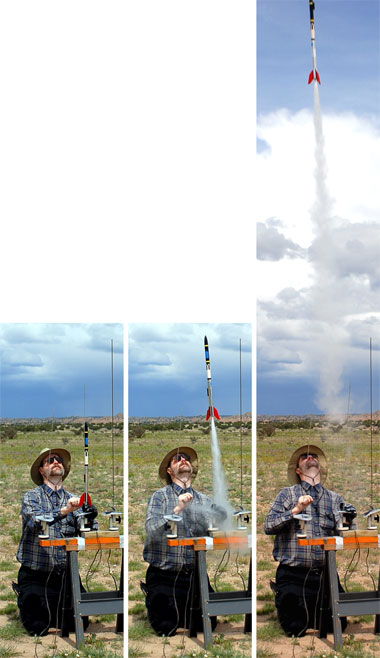Tom’s Vashon Rocketry Site
| Return to My Fleet |  |
Video Valkyrie This is just my Valkyrie-2 model with a video camera payload attached (in my quest to do things never done before with cold power rockets). The camera is a Multipod 5-in-1 unit that can record several minutes of 320 x 240 video with sound at 30 frames per second. The movie is stored in flash memory and can be downloaded to computer by plugging the Multipod into a USB port (the device also acts as a USB flash drive ...as well as taking still photos, taking movies, making audio recordings, and acting as a web-cam ...hence the 5-in-1 name). I've flown the Multipod many times on larger model rockets and high-power rockets with the camera simply sticking out the side of the model with its lens facing downward. To adapt the Multipod to the Valkyrie, I had to orient it vertically inside a piece of ST-9 body tube with the lens looking out the side of the rocket. I used the small first-surface mirror and plastic mirror hood from an old Estes Astrocam to reflect the view of the camera downward along the body of the rocket. There is a small amount of vignetting because the mirror should really be a bit larger, but it's not too bad. Holes located in the side of the payload section opposite the mirror hood allow access to the Multipod's control buttons. The black paint job and yellow tape are just to give the video payload a Cineroc look.
Flight #1 April 27, 2007 Flight #1 was made at White Rock Overlook Park in Los Alamos County, New Mexico. To see the Quicktime movie of the flight, click here (to view the video, you will need the Quicktime plugin, which is available for free download at www.apple.com/quicktime/download/). This video has been reduced to 15 frames per second and is more compressed than the original (which was 30 fps). The video image has been flipped to compensate for the effect of the mirror. Most of the whistling noises are due to wind entering the holes in the camera payload section. There were a couple anomalies on the flight: 1) I forgot to remove the vent pin before launch, so the pin and its wire are in the view during boost; 2) The thrust appears to terminate at 0.85 seconds, or at least that's when the thick exhaust trail stops; 3) The time delay was longer that my ground tests indicated it would be, so the rocket came back down quite a ways before parachute deployment; 4) During the jiggling around after parachute deployment, the V-2 motor came unscrewed from the separator and the rocket body fell by itself, but it landed without damage.
|
|
Below are some annotated frames captured at full resolution from the original video. Temperature at launch was 75 degrees F and winds were about 7 mph.

Handy tip: It would be a good idea to put a small piece of tape on the motor/separator joint to prevent the motor from twisting loose (I avoid over-tightening the motor because that can damage the connectors).
Flight #2 May 20, 2007
Flight #2 was made at our club's monthly sport launch near Española, New Mexico. To see the Quicktime movie of the flight, click here (to view the video, you will need the Quicktime plugin, available for free download at www.apple.com/quicktime/download/). This video has been reduced to 15 frames per second and is more compressed than the original (which was 30 fps). The video image has been flipped to compensate for the effect of the mirror. For this flight I covered the openings in the payload section (except for the hole the camera looks out) with tape to reduce wind noise. It also muffles the sound somewhat.
There were some anomalies on this flight as well: 1) The thrust appears to terminate by 0.8 seconds, sooner than I expected from ground test firings; 2) The time delay was much longer that my ground tests indicated it would be, so the rocket came almost all of the way back down before parachute deployment; 3) Due to the high-speed deployment, the chute was ripped away (the elastic shock cord broke); 4) Luckily, the chute slowed the rocket down considerably as it snapped free, so the Valkyrie and camera payload were able to fall the remaining short distance to the ground without damage, other than a slight crimp in the payload section tube.
Below are some annotated frames captured at full resolution from the original video. Temperature at launch was 72 degrees F and winds were about 6 mph. The sky was partly cloudy with a high overcast layer.

Below is the liftoff sequence of flight #2 taken at 5 frames per second by Meghan Wilson. Calculation of the rocket's acceleration is left as an exercise for the student.

Page last updated May 22, 2007

